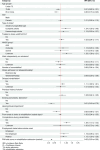Delayed inpatient rehabilitation and functional outcomes for acute stroke: a retrospective cohort study in an Australian regional hospital
- PMID: 40762230
- PMCID: PMC12340994
- DOI: 10.2340/jrm.v57.42506
Delayed inpatient rehabilitation and functional outcomes for acute stroke: a retrospective cohort study in an Australian regional hospital
Abstract
Background: The impact of delayed inpatient rehabilitation on the functional outcomes of stroke patients has not been reported in regional Australia.
Objective: This study examined the impact of delayed inpatient rehabilitation following acute stroke on functional outcomes (Relative Functional Gain and Functional Independence Measure efficiency) and length of stay in rehabilitation at a regional Australian hospital.
Methods: Rehabilitation initiated > 24 h after a patient was deemed clinically ready was considered delayed. Associations between delayed inpatient rehabilitation and functional outcomes were investigated with mixed effects linear regression while length of stay was modelled using a negative binomial regression.
Results: Of a total 487 patients, 301 (61.8%) experienced delayed inpatient rehabilitation, with a median delay of 2 days (interquartile range: 1-4 days). Multivariate regressions showed delayed inpatient rehabilitation was negatively associated with Relative Functional Gain (Beta: -0.07, 95% confidence interval [CI]: -0.11, -0.02, p = 0.009) and Functional Independence Measure efficiency (Beta: -0.18, 95% CI: -0.32, -0.04, p = 0.014), but positively associated with length of stay in rehabilitation wards (incidence rate ratio: 1.11, 95% CI: 1.02, 1.21, p = 0.021). Bed unavailability was the leading cause of delay.
Conclusion: Delayed inpatient rehabilitation is associated with poorer functional outcomes in stroke patients. Timely access to rehabilitation is crucial for optimising recovery.
Conflict of interest statement
Figures
Similar articles
-
Organised inpatient (stroke unit) care for stroke: network meta-analysis.Cochrane Database Syst Rev. 2020 Apr 23;4(4):CD000197. doi: 10.1002/14651858.CD000197.pub4. Cochrane Database Syst Rev. 2020. PMID: 32324916 Free PMC article.
-
Multidisciplinary rehabilitation for older people with hip fractures.Cochrane Database Syst Rev. 2021 Nov 12;11(11):CD007125. doi: 10.1002/14651858.CD007125.pub3. Cochrane Database Syst Rev. 2021. PMID: 34766330 Free PMC article.
-
Activity monitors for increasing physical activity in adult stroke survivors.Cochrane Database Syst Rev. 2018 Jul 27;7(7):CD012543. doi: 10.1002/14651858.CD012543.pub2. Cochrane Database Syst Rev. 2018. PMID: 30051462 Free PMC article.
-
Physical rehabilitation approaches for the recovery of function and mobility following stroke.Cochrane Database Syst Rev. 2025 Feb 11;2(2):CD001920. doi: 10.1002/14651858.CD001920.pub4. Cochrane Database Syst Rev. 2025. PMID: 39932103 Free PMC article.
-
Yoga for stroke rehabilitation.Cochrane Database Syst Rev. 2017 Dec 8;12(12):CD011483. doi: 10.1002/14651858.CD011483.pub2. Cochrane Database Syst Rev. 2017. PMID: 29220541 Free PMC article.
References
-
- National Clinical Guideline for Stroke for the UK and Ireland. Rehabilitation and recovery – principles of rehabilitation 2023. Available from: https://www.strokeguideline.org/chapter/rehabilitation-and-recovery-prin...
MeSH terms
LinkOut - more resources
Full Text Sources
Medical



